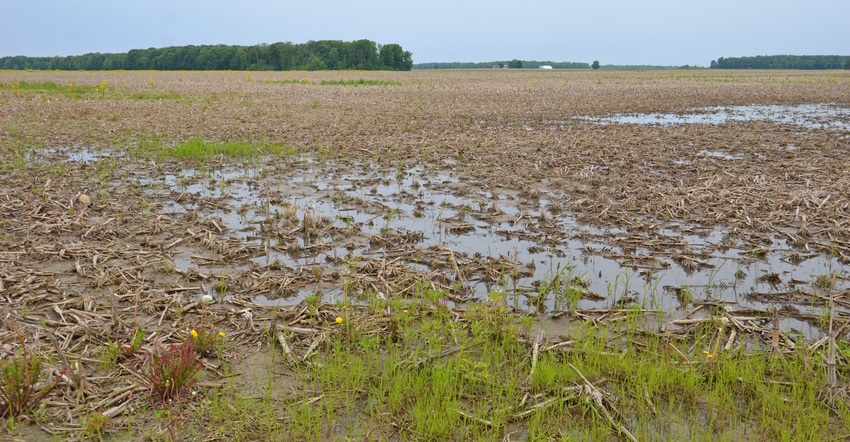
Not everywhere received 10 days of rain in a row from June 15 through June 24, but there are no areas in Indiana wanting for moisture. That was evident in Greg Matli’s weekly report of crop progress issued June 24. Matli is the Indiana state statistician for USDA’s National Agricultural Statistics Service.
Matli reports that 53% of reporting stations noted surplus topsoil moisture, and 47% reported adequate moisture; no areas were short on moisture. Subsoil moisture was 52% surplus and 48% adequate. Statewide, there were 2.2 days suitable for field work last week. In many areas, there were no days to get in the field. Temperatures averaged 70.5 degrees F for the week, 1.9 degrees below normal, continuing the cool trend.
Other data reported by Matli emphasizes how far behind Indiana’s crop progress is in 2019 compared to other years. Corn planting finished at 91%, versus 100% in 2018 and for the five-year average. Only 79% of that corn had emerged, versus 100% last year and 98% for the five-year average. Soybean planting stood at 75%, up from 64% the week before and 97% for the five-year average. Only 56% of beans had emerged, compared to 92% for the five-year average.
Hampered by cool weather, only 49% of winter wheat was mature, compared to 64% for the five-year average. Some 10% of winter wheat was harvested, compared to 21% for the five-year average.
Of cornfields that had emerged, 43% were rated good or excellent. That number is comparable to 2015 and 2017 for the same period, but way below 2016 and 2018.
First cutting of alfalfa hay was 55% complete as of June 23, far below 97% last year and 94% for the five-year average. Cutting of other hay, including grass hay, was 59% complete, compared to 90% in 2018 and 88% for the five-year average.
Helpful resources
The data tells the story: It’s been a dismal start to 2019 on all fronts. Lisa Holscher, executive director of the Conservation Cropping Systems Initiative, says CCSI has put together a bevy of online resources to help farmers find information, particularly if they’re dealing with prevented planting acres or questions about crop insurance.
“We decided to gather as many links to resources and decision-making tools on our website as we could,” she says.
Holscher and her staff reached out to various agencies for help. They include USDA’s Risk Management Agency, Indiana Natural Resources Conservation Service, Indiana Department of Environmental Management, Purdue University Extension and the Midwest Cover Crops Council. Find links to these agencies through the CCSI website.
“We tried to provide details on a number of topics, and have it designed so that if you scroll down the site, you can find links to these topics,” Holscher adds.
Topics with links include crop insurance, cover crops, prevented planting decision tools for corn and soybeans, forage management, weed management, manure storage and use, and mental health resources.
For example, suppose you want to know what the RMA says about when you can plant cover crops on prevented planting acres, and if that will affect your APH on those acres. In other articles on the Indiana Prairie Farmer website, you will read that if you follow all applicable rules, APH won’t be affected. But on the CCSI site, you can link directly to RMA and a list of frequently asked questions, including about cover crops and prevented planting.
Suppose you want to know how to best control weeds on prevented planting acres. Cover crops are one option, but not the only one. From the CCSI link, scroll down to “weed management considerations” and find several resources. One is a bulletin from Aaron Hager, weed scientist at the University of Illinois.
He offers tips such as not applying residual herbicides and thinking they will control weeds all season, because they likely won’t without a crop present. If you’re seeding a cover crop, Hager suggests cleaning up existing weeds first, either with tillage or herbicide. If you use a nonresidual herbicide, he says you may have to wait several days for the herbicide to control weeds.
About the Author(s)
You May Also Like




